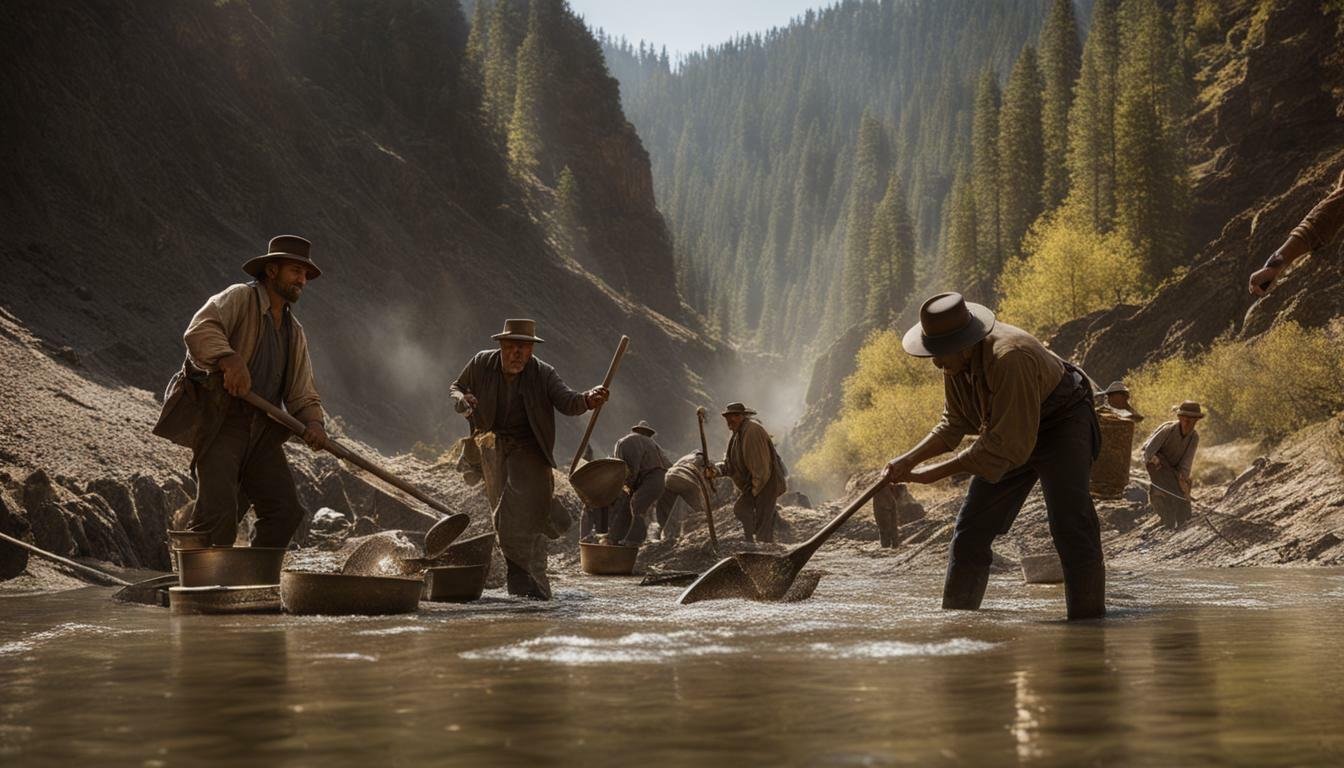How Did Miners Stake a Claim in the Gold Rush?
The gold rush was a defining moment in American history, and understanding how miners staked their claim to gold is key to unraveling this fascinating chapter. During this era, adventurous individuals from all walks of life flocked to the gold fields in search of fortune.
Miners believed that by staking a claim to a piece of land, they could secure their rights to any gold deposits found within it.
One such miner who struck gold was William Scouse, whose claim on Eldorado Creek in the Yukon Valley turned out to be fabulously rich. His diary, recently discovered, provides a firsthand account of the Klondike’s significant gold strike, offering a glimpse into the exhilaration and challenges faced by miners during that time.
Key Takeaways about How Did Miners Stake a Claim in the Gold Rush
🌍 The Gold Rush was a significant chapter in American history, attracting individuals worldwide with the promise of wealth and opportunity.
⛏️ Miners like William Scouse and George Hearst struck gold, with some amassing and maintaining substantial fortunes, despite challenges such as high living costs and various temptations.
🏠 The massive migration during the Gold Rush led to the establishment and rapid growth of towns and cities, creating vibrant, diverse communities and fostering infrastructural development.
💰 Quartz mining emerged as a profitable alternative to traditional methods, providing a steady income for adaptable miners, and playing a pivotal role in the region’s economic development.
📜 The Gold Rush’s legacy continues to impact American history and culture, reflecting the endeavors and indomitable spirit of the pioneers who risked everything in search of fortune.
While many prospectors experienced initial success, the reality was that few were able to hold onto their newfound wealth. The high cost of living, coupled with temptations like alcohol and gambling, made it difficult for miners to maintain their financial gains.
Nevertheless, there were exceptions. Individuals like George Hearst and Jean-Baptiste Charbonneau managed to defy the odds and accumulate significant wealth during the gold rush. Their stories serve as a testament to the perseverance and ingenuity of those who found success.
Quartz mining emerged as a lucrative alternative during the gold rush, exemplified by George Hearst’s prosperous ventures. This new form of mining offered a way for miners to extract gold from quartz veins, ensuring a steady stream of wealth for those who could adapt to the changing times.
Buy Gold Online: The Smart and Secure Way
Discover the safest and most reliable strategies to buy gold online. Make informed investment decisions and secure your financial future today!
Learn MoreThe pursuit of gold in the Americas not only led to massive migrations but also played a crucial role in shaping American history and culture. The discovery of gold in California in 1848 triggered a rush of settlers and the rapid colonization of new towns and cities.
As we embark on this journey to explore the gold rush and how miners staked their claim to the precious metal, let us uncover the untold stories, the triumphs, and the challenges that shaped this unique chapter in American history.
The Quest for Gold: A Driving Force Behind Migration
The allure of gold has driven countless adventurers to set off on perilous journeys, seeking their fortunes in new lands. The discovery of gold has often sparked mass migrations, as individuals from all walks of life are captivated by the promise of wealth and a better future. The gold rush in the Americas during the 19th century is a testament to this phenomenon, as people from around the world flocked to gold-rich regions like California, Alaska, and the Yukon Valley.
The pursuit of gold during the gold rush era was not limited to a specific group or nationality. It attracted people from diverse backgrounds, including miners, prospectors, businessmen, and even farmers who abandoned their fields in search of golden opportunities. The migration stimulated by the gold rush had a profound impact on the regions involved, shaping their history and culture in significant ways.
The quest for gold brought together individuals from different parts of the world, creating a melting pot of cultures and ideas. It fueled the growth of new towns and cities, as well as the development of infrastructure, such as roads, railroads, and telegraph lines, to support the influx of prospectors. The lure of potential wealth transformed these remote areas into bustling hubs of activity, attracting not only miners but also merchants, entrepreneurs, and opportunists looking to capitalize on the newfound demand.
The gold rush era was marked by stories of both triumph and tragedy. While some individuals struck it rich and achieved unimaginable wealth, many others faced disappointment and hardship. The pursuit of gold was a gamble, with only a fortunate few finding substantial deposits. Yet, the allure of striking it rich continued to draw people, each hoping to be the next lucky prospector to uncover a treasure trove. The legacy of this era lives on, as the gold rush not only shaped the landscapes and economies of the regions it touched but also left an indelible mark on American history and culture.
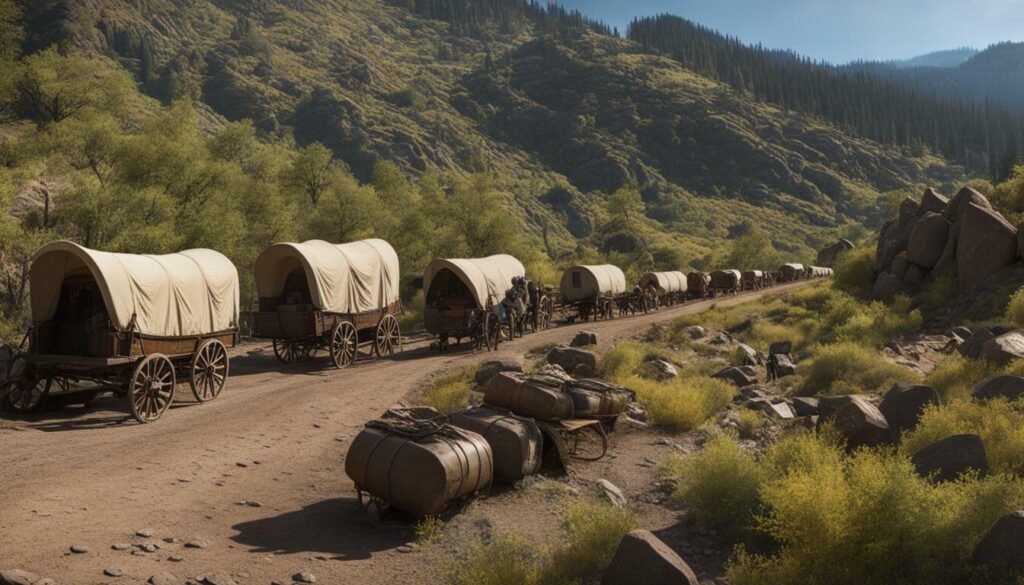
- The gold rush era attracted people from diverse backgrounds, driving mass migration to gold-rich regions.
- The pursuit of gold transformed remote areas into bustling hubs of activity, fostering the growth of new towns and cities.
- The allure of striking it rich drew countless individuals, but only a few found substantial deposits of gold.
- The gold rush era left a lasting impact on American history and culture, shaping the development of regions and inspiring tales of triumph and tragedy.
| Region | Years | Significant Gold Strikes |
|---|---|---|
| California | 1848-1855 | Sutter’s Mill, Grass Valley, Sierra Nevada |
| Alaska | 1896-1899 | Klondike River, Nome |
| Yukon Valley | 1896-1898 | Eldorado Creek, Bonanza Creek |
“The discovery of gold brought an influx of people from all corners of the world, converging on these remote regions in search of untold riches. It was a time of both excitement and uncertainty, as fortunes were made and dreams were shattered.” – Gold Rush Chronicles
The Gold Rush: A Catalyst for Colonization
The discovery of gold in California in 1848 sparked a frenzy that forever transformed the landscape and fortunes of the American West. The promise of riches lured thousands of individuals from all walks of life, fueling a massive migration of prospectors and settlers eager to stake their claim. The gold rush became a catalyst for colonization as people flocked to the region in search of their fortunes.
One of the most influential impacts of the gold rush was the rapid colonization that followed the discovery of gold. Towns and cities sprang up practically overnight, creating a bustling frontier society. The influx of people seeking their share of the gold led to the establishment of new communities, infrastructure, and institutions. This wave of colonization forever changed the demographics and cultural landscape of the American West.
| City | Population (1850) |
|---|---|
| San Francisco | 25,000 |
| Sacramento | 6,800 |
| Stockton | 2,500 |
However, the pursuit of gold also had its challenges. While some prospectors managed to strike it rich initially, the expensive cost of living in the gold rush towns often eroded their newfound wealth. Miners had to contend with exorbitant prices for basic goods and services, leaving many struggling to make ends meet. The temptations of vices, such as alcohol and gambling, further drained their resources, making it difficult to hold onto their wealth.
“The Klondike’s significant gold strike on Eldorado Creek has been a life-changing experience. The riverbanks were lined with miners, all hoping to strike gold. It was a challenging journey, but the rewards are beyond imagination.” – William Scouse
Nevertheless, a few individuals defied the odds and managed to accumulate considerable wealth during the gold rush. William Scouse, for example, staked his claim on Eldorado Creek in the Yukon Valley, which turned out to be fabulously rich in gold. Scouse’s diary, recently discovered, provides a firsthand account of the Klondike’s significant gold strike, showcasing the potential wealth that awaited those fortunate enough to find a substantial gold deposit.
Other notable success stories during the gold rush include George Hearst and Jean-Baptiste Charbonneau. Hearst not only obtained wealth during the gold rush but also maintained it through successful ventures like quartz mining. Charbonneau, the son of famous explorer Sacagawea, accumulated wealth through his mining endeavors, despite the challenges faced by many prospectors.
Quartz Mining: A Lucrative Alternative
Quartz mining emerged as a lucrative alternative to traditional placer mining during the gold rush. George Hearst’s success in quartz mining exemplified the profitability of this method. By extracting gold from quartz veins embedded in rock, miners were able to access previously untapped wealth. This shift in mining techniques played a significant role in sustaining the economic growth and development of the gold rush region.
The enduring legacy of the gold rush continues to shape American history and culture. It remains a testament to the indomitable spirit of the pioneers who risked everything to seek their fortunes. The impact of the gold rush on the colonization of the American West cannot be overstated, as it forever altered the course of history and set the stage for the growth and expansion of the United States.

To stake a claim during the gold rush, miners needed to follow a set of rules and procedures to secure their right to potential riches. The process began with identifying a piece of land where gold was believed to be present. Miners would then mark the boundaries of their claim using wooden stakes or other markers, clearly indicating their intent to mine the area. This was crucial to avoid disputes and establish ownership.
Once the claim was marked, miners were required to record their claim with the local authorities. This involved filing a claim notice or certificate, providing details such as the miner’s name, the location of the claim, and the size of the area being claimed. This official documentation served as proof of ownership and protected miners from others attempting to encroach on their claim.
| Rule | Procedure |
|---|---|
| 1 | Identify the land with potential gold deposits. |
| 2 | Mark the boundaries of the claim to establish ownership. |
| 3 | File a claim notice or certificate with local authorities. |
One important aspect of staking a claim was the concept of “first discovery.” The person who first discovered gold in a particular area had the right to stake the first claim, known as a “discovery claim.” This claim would grant the miner additional privileges and set the precedence for other miners in the region.
Staking a claim during the gold rush was not without risks and challenges. Competing claims, disputes, and fraudulent practices were common. Miners had to be vigilant and protect their claims by monitoring their boundaries and resolving disagreements through legal means when necessary. Nonetheless, staking a claim was an essential step in the pursuit of gold during this historic era.
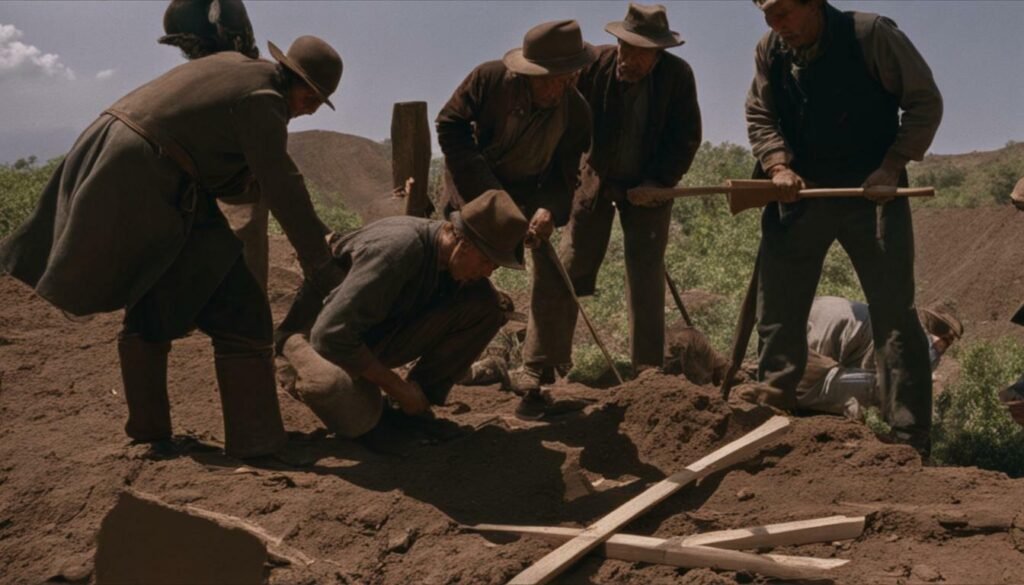
William Scouse’s diary, recently discovered, provides a firsthand account of his remarkable success in the Klondike’s gold strike. Born in Ohio, Scouse was captivated by the allure of striking it rich during the gold rush. Like countless others, he ventured to Eldorado Creek in the Yukon Valley, driven by the promise of untold wealth.
Scouse’s persistence paid off when he staked his claim in Eldorado Creek, unearthing a gold deposit that exceeded all expectations. The discovery catapulted him into a life of unimaginable wealth, transforming him from an ordinary prospector into a legend of the Klondike. His diary entries vividly capture the euphoria of finding gold and the challenges he faced while navigating the treacherous landscape of the gold rush.
“Today, I struck gold! The sight of those shimmering nuggets glistening in my hands is indescribable. The hard work, the countless hours spent sifting through dirt and gravel, have finally paid off. I am now a wealthy man, with possibilities as endless as the glittering rivers of gold that flow through Eldorado Creek.”
– William Scouse, Diary Entry, September 12, 1898.
Scouse’s success story ignited the dreams of countless others who flocked to the Klondike, hoping to replicate his extraordinary fortune. However, for many prospectors, the reality of the gold rush proved less glamorous. The high cost of living in remote mining towns often outweighed their earnings, and vices like alcohol and gambling proved irresistible temptations that eroded newfound wealth.
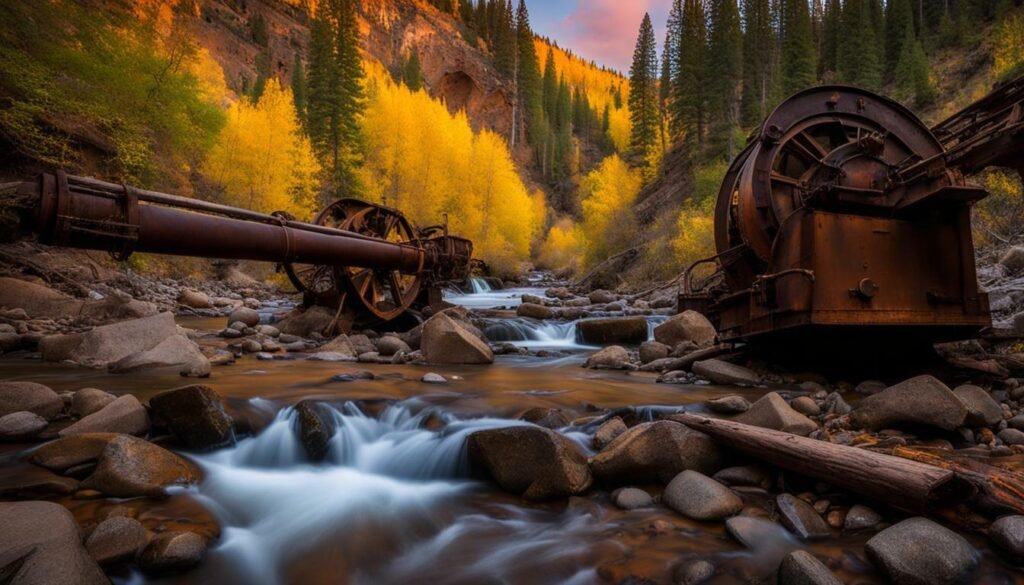
Eldorado Creek: A Shining Beacon in the Yukon Valley
Eldorado Creek, nestled in the untamed wilderness of the Yukon Valley, became synonymous with hope and riches during the gold rush. It attracted a diverse array of miners from all walks of life, united by their shared ambition to strike gold and build a better future.
| Key Facts about Eldorado Creek | |
|---|---|
| – Location: Yukon Valley, Klondike Region | |
| – Discovery: August 1896 | |
| – Estimated Gold Deposits: Over 2 million ounces | |
| – Notable Strikes: William Scouse, August 1898 |
The allure of Eldorado Creek’s riches continues to captivate imaginations today, its legacy forever etched in the annals of gold rush history.
The Rise and Fall of Fortunes
While many miners experienced initial success, the road to long-term wealth during the gold rush was fraught with obstacles that only a few managed to overcome. The allure of newfound wealth drew prospectors from all corners of the globe to the gold fields, but the expensive cost of living and the temptations of vices like alcohol and gambling proved to be formidable challenges.
As miners struck gold, their lives changed dramatically. They went from struggling to make ends meet to suddenly having access to immense wealth. However, the high cost of living in mining towns often meant that miners had to spend much of their newfound riches on basic necessities like food and lodging. Many also fell victim to the temptations that came with newfound wealth, indulging in alcohol and gambling, which further depleted their fortunes.
Despite these challenges, a few individuals managed to navigate the treacherous path to long-term prosperity. George Hearst, for example, emerged as one such success story. He not only obtained wealth during the gold rush but also made smart investments in quartz mining, which allowed him to maintain his wealth and establish a lasting legacy. Jean-Baptiste Charbonneau, the son of Sacagawea, also defied the odds and accumulated wealth during the gold rush.
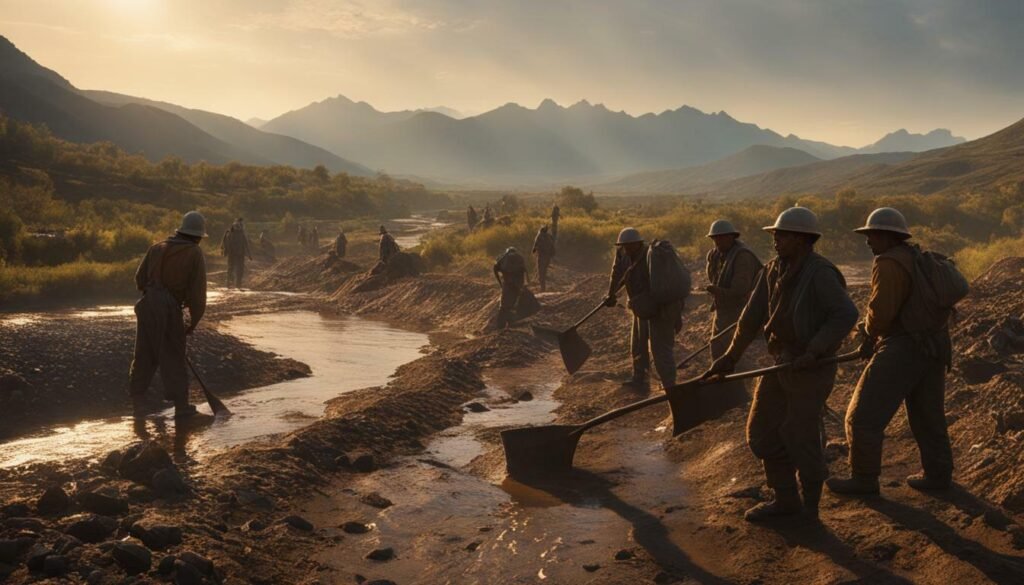
| Miner | Wealth Accumulated | Notable Accomplishments |
|---|---|---|
| William Scouse | Fabulously rich on Eldorado Creek, Yukon Valley | Diary provides first-hand account of Klondike’s gold strike |
| George Hearst | Obtained wealth during gold rush, maintained it through successful quartz mining | Established a lasting legacy and accumulated significant wealth |
| Jean-Baptiste Charbonneau | Accumulated wealth during the gold rush | Defied the odds and achieved financial success |
Quartz mining emerged as a lucrative alternative to traditional mining methods during the gold rush. It required less labor and equipment, making it a more cost-effective option. George Hearst’s success in quartz mining highlights its profitability and contributed to the enduring legacy of the gold rush. The pursuit of gold in the Americas has played a significant role in shaping American history and culture, with the gold rush serving as a catalyst for colonization and migration.
George Hearst: From Rags to Riches
George Hearst’s journey from modest beginnings to becoming one of the wealthiest men of his time exemplifies the opportunities that the gold rush presented. Born in 1820 in Sullivan, Missouri, Hearst started his career as a miner in the goldfields of California.
Unlike many other prospectors, Hearst’s fortunes steadily grew as he expanded his operations. He recognized the potential of quartz mining, a method that involved extracting gold from quartz veins. It proved to be a lucrative alternative to traditional placer mining, which involved panning for gold in rivers and streams.
The Success of Quartz Mining
Quartz mining required significant investment and technical expertise, but it offered higher yields and a more sustainable source of wealth. Hearst’s success in quartz mining played a crucial role in his rise to prominence in the mining industry.
His wealth and influence extended beyond the goldfields. Hearst later ventured into banking, real estate, and media, becoming a prominent figure in American business and politics. He even served as a U.S. Senator from California.
The enduring legacy of George Hearst’s success during the gold rush remains a testament to the opportunities that arose from this historic era. His story is just one example of how individuals seized the chance to stake their claim and emerge from the gold rush not only with newfound wealth but also with the potential to shape the future of the nation.
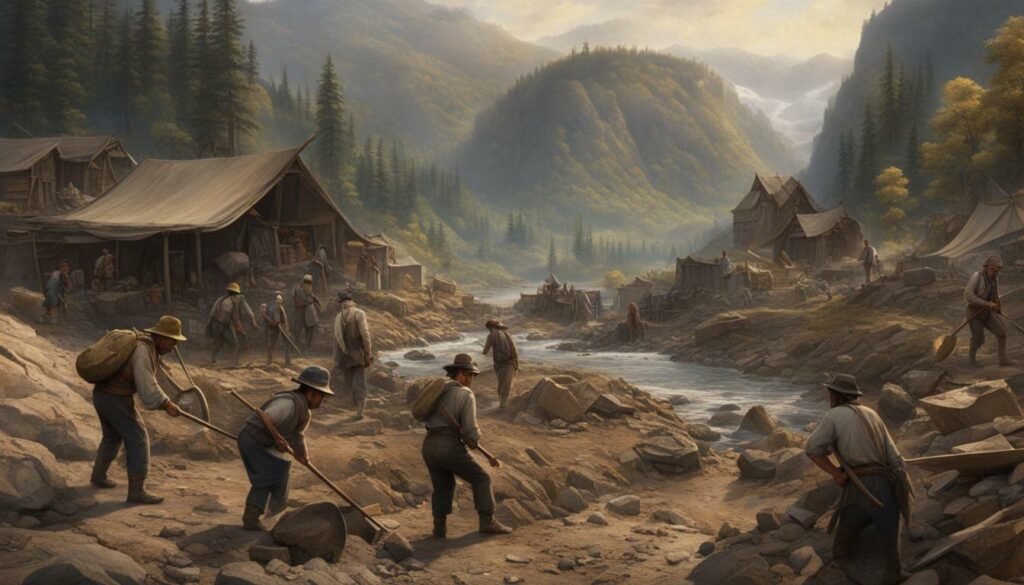
| Key takeaways |
|---|
| 1. George Hearst’s journey from modest beginnings to immense wealth reflects the opportunities offered during the gold rush. |
| 2. Quartz mining, a lucrative alternative to placer mining, contributed to Hearst’s success and enduring wealth. |
| 3. His accomplishments extended beyond mining, with ventures in banking, real estate, and media, solidifying his place in American history. |
Jean-Baptiste Charbonneau: A Unique Success Story
Jean-Baptiste Charbonneau’s story of achieving financial success in the midst of the gold rush showcases the determination and resourcefulness of individuals during this time. Born to an African-American slave mother and the French explorer, Sacagawea, Charbonneau’s mixed heritage placed him in a unique position. His linguistic abilities and familiarity with the terrain allowed him to navigate the challenges of the gold rush with ease, ultimately leading him to great prosperity.
At the age of 18, Charbonneau ventured into the gold fields of California, armed with little more than his ambition and a pickaxe. His hard work paid off when he discovered a substantial gold deposit in the Sierra Nevada. With each successful claim, he amassed wealth that exceeded the dreams of many miners.
Charbonneau’s remarkable wealth allowed him to invest in various business ventures, including real estate and farming. He became known as a shrewd businessman, leveraging his resources to expand his empire and secure his financial future. His success story inspired others during a time when fortunes were made and lost in the blink of an eye.
The Determination to Succeed
Charbonneau’s journey to financial success was not without its challenges. He faced discrimination and prejudice due to his mixed heritage, but he refused to let that define him. With unwavering determination, he forged his own path and proved that success knows no bounds.

| Key Factors in Jean-Baptiste Charbonneau’s Success |
|---|
| 1. Linguistic skills |
| 2. Familiarity with the terrain |
| 3. Hard work and perseverance |
| 4. Shrewd business acumen |
“I have seen the best and worst of humanity in the gold rush,” Charbonneau wrote in his memoir. “It was a time of great opportunity and adversity, and I am grateful for the lessons it taught me.”
Charbonneau’s legacy extends far beyond the gold rush era. His triumph over adversity serves as an inspiration to individuals striving for success in any endeavor. His story reminds us that the determination and resourcefulness of individuals can overcome even the most challenging circumstances.
Quartz Mining: A Lucrative Alternative
While traditional placer mining dominated the gold rush, quartz mining emerged as a highly profitable alternative, attracting miners seeking even greater riches. Unlike placer mining, which involved extracting gold from loose materials like sand and gravel, quartz mining required more advanced techniques and specialized equipment.
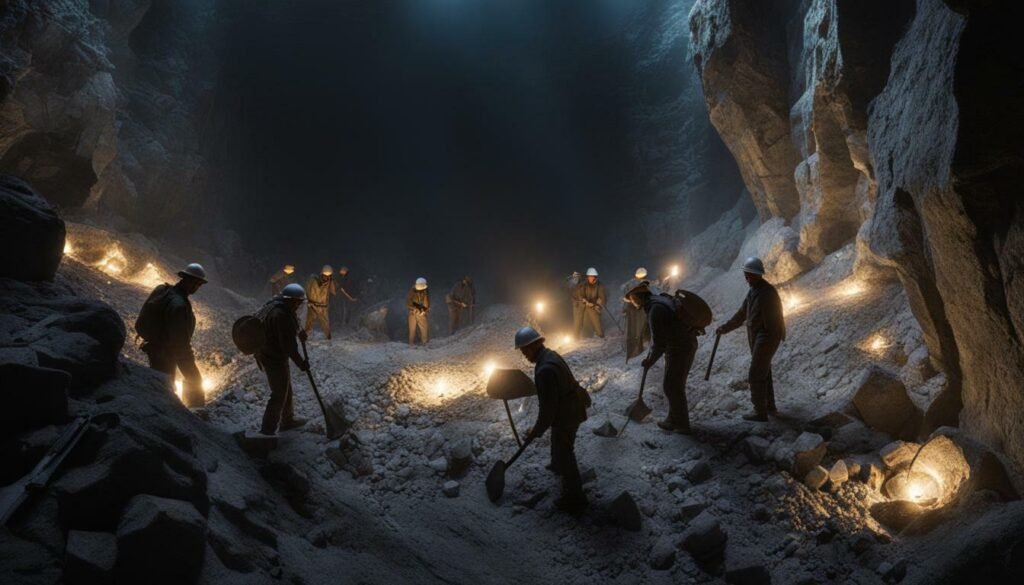
Quartz mining involved extracting gold from quartz veins embedded in rocks, requiring miners to crush the quartz and extract the gold using various methods. This process was more labor-intensive and required more capital investment, but it often yielded higher quantities of gold.
In addition to the technological advancements, quartz mining offered several advantages over placer mining. Quartz veins were often richer in gold and had a more concentrated gold content, making it more efficient and profitable for miners. Furthermore, quartz mining had a more predictable and steady production rate, providing a stable source of income for those engaged in this method.
| Methods | Advantages |
|---|---|
| Stamp Mills | Efficient crushing of quartz and extraction of gold |
| Arrastras | Simple and cost-effective extraction method |
| Quartz Mining Companies | Pooling resources for large-scale operations |
Miners who engaged in quartz mining often formed companies to combine their resources and undertake larger-scale operations. These companies had the advantage of larger capital investment and the ability to procure advanced machinery, resulting in increased productivity and higher profits.
Overall, quartz mining proved to be a lucrative alternative to placer mining during the gold rush. It attracted miners who were willing to invest more time, effort, and capital in exchange for the potential of greater wealth. Through the advancements in technology and the pursuit of greater riches, quartz mining played a significant role in shaping the outcomes of the gold rush era.
The Enduring Legacy of the Gold Rush
The gold rush left an indelible mark on American history, forever altering the nation’s trajectory and leaving a lasting cultural legacy. This pivotal event, sparked by the discovery of gold in California in 1848, led to a massive influx of fortune seekers from around the world, profoundly shaping the development of the United States. The promise of wealth and opportunity drove thousands to venture west, resulting in the rapid colonization of previously untamed territories.

As miners staked their claims and embarked on the quest for gold, the gold rush became a driving force behind migration. This influx of people from various backgrounds and cultures not only reshaped the demographics of the nation but also contributed to the emergence of a distinct American identity. The diversity brought by these migrants fueled a cultural melting pot, influencing everything from cuisine to language and music.
While many miners initially struck fortune, the expensive cost of living and temptations like alcohol and gambling made it challenging to hold onto their newfound wealth. However, a few individuals managed to rise above the odds. Figures like George Hearst and Jean-Baptiste Charbonneau not only accumulated wealth but also maintained their fortunes through successful ventures. Their stories serve as a testament to the determination and entrepreneurial spirit of those involved in the gold rush.
In addition to traditional gold mining, quartz mining emerged as a lucrative alternative during the gold rush. George Hearst’s success in this endeavor highlights the profitability and continued impact of quartz mining on the American economy. The enduring legacy of the gold rush extends beyond individual success stories, influencing the development of infrastructure, economies, and societal norms.
| Gold Rush Impact Areas | Examples |
|---|---|
| Infrastructure | Building of towns, roads, and railways to support mining operations |
| Economy | Growth of trade, rise of banking and financial institutions |
| Social | Diversity, cultural exchange, and the shaping of American identity |
| Environmental | Ecosystem disruption, deforestation, and water pollution |
The gold rush holds a prominent place in the annals of American history, serving as a testament to the resilience, ambition, and dreams of those who sought their fortune in the untamed West. Its enduring legacy can be seen not only in the physical remnants of mining towns and infrastructure but also in the cultural fabric of the nation. The gold rush symbolizes the pursuit of opportunity, the impact of migration, and the transformative power of new discoveries.
Conclusion
The gold rush was a remarkable era where miners risked it all in the pursuit of gold, staking their claims and leaving an indelible mark on the history of the United States. During this period, miners fiercely competed to assert ownership over a piece of land where they believed gold could be found. The discovery of gold in California in 1848 triggered a rush of settlers, leading to the rapid colonization of new towns and cities. Migration became a driving force as people from all over flocked to the Americas in search of riches.
One miner, William Scouse, struck it rich on Eldorado Creek in the Yukon Valley. His diary, recently discovered, provides a firsthand account of the Klondike’s significant gold strike. While many prospectors found initial success, few were able to hold onto their newfound wealth. The cost of living was exorbitant, and temptations like alcohol and gambling proved to be constant challenges.
However, there were exceptions. Individuals like George Hearst and Jean-Baptiste Charbonneau managed to achieve wealth and maintain it through their successful ventures. Quartz mining emerged as a lucrative alternative during the gold rush, exemplified by the success of George Hearst. This method of extracting gold from quartz rock proved to be highly profitable.
The enduring legacy of the gold rush continues to shape American history and culture. The pursuit of gold played a pivotal role in driving colonization and migration, forever altering the landscape of the United States. The stories of miners staking their claims and seeking their fortunes serve as a testament to the unwavering spirit and determination of those who sought to strike gold during this transformative period.
FAQ About How Did Miners Stake a Claim in the Gold Rush
How did miners stake a claim during the gold rush?
Miners staked a claim to a piece of land where they believed there was gold. This involved physically marking the boundaries of their claim and registering their ownership with the relevant authorities.
What was the impact of the gold rush on migration?
The pursuit of gold in the Americas led to massive migrations as people sought their fortunes. The discovery of gold often triggered rapid settlement and the formation of new towns and cities.
How did the gold rush contribute to colonization?
The discovery of gold, such as in California in 1848, served as a catalyst for colonization. The influx of gold seekers led to the rapid development of new territories and the establishment of communities.
What was the process of staking a claim?
Staking a claim involved marking the boundaries of a piece of land believed to contain gold and asserting ownership over it. Miners would then register their claim with the appropriate authorities to establish legal ownership.
Who was William Scouse and what was his story?
William Scouse was a miner who staked a claim on Eldorado Creek in the Yukon Valley during the gold rush. His claim turned out to be fabulously rich, and his diary provides a firsthand account of the significant gold strike.
Why did some miners struggle to hold onto their newfound wealth?
Many miners faced challenges in holding onto their newfound wealth due to the expensive cost of living in gold rush towns and the temptations of vices like alcohol and gambling.
Who was George Hearst and how did he get rich?
George Hearst was an individual who managed to obtain wealth during the gold rush and maintain it through successful ventures like quartz mining. His story exemplifies the potential for success in mining during this time.
Who was Jean-Baptiste Charbonneau and what made his success unique?
Jean-Baptiste Charbonneau was a miner who defied the odds and accumulated wealth during the gold rush. His success was unique because many prospectors struggled to maintain their wealth, but Charbonneau managed to do so.
Was quartz mining profitable during the gold rush?
Yes, quartz mining was a lucrative alternative during the gold rush. George Hearst’s success in this field demonstrates the profitability of quartz mining during this time.
What was the lasting impact of the gold rush on American history and culture?
The gold rush had a significant impact on American history and culture. It played a pivotal role in driving migration and colonization, shaping the nation’s development, and leaving a lasting legacy in American folklore and identity.

